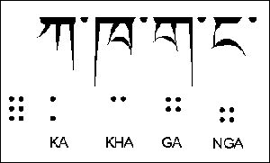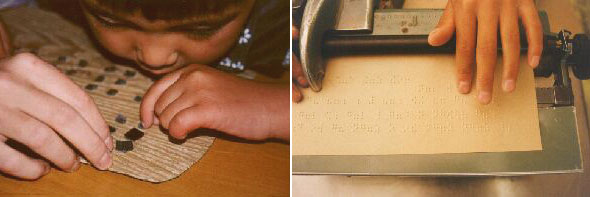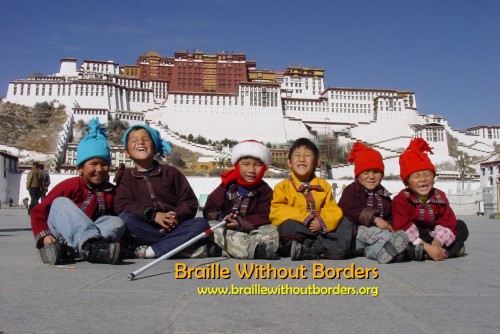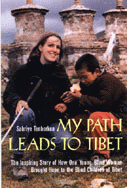|
Click to make font larger
Click to make font smaller
welcome to the website of Braille Without Borders.
Dear reader, In 1998, Braille Without Borders started the first school for the blind in Tibet.
According
to the local laws and regulations, a foreign NGO is only allowed to
work in Tibet when it has an agreement with a local governmental
partner. The local partner that BWB worked with was the Tibet Disabled Persons Federation.
in
the summer of 2017, the agreement was not renewed and this meant that
BWB had to hand over the entire project to the Tibet Disabled Persons
Federation. BWB was one of the last foreign NGO's that was still active
in Tibet. PLEASE NOTE: This website describes the work of BWB throughout the years that it was working in Tibet.
(1998 till 2017) This however does not mean that the work of Braille Without Borders ends here.
Since 2009 BWB created a second project.
This
project, named 'kanthari' is an international impact Leadership training
Institute for individuals who come from the margins of society, who
have overcome adversity and because of that carry a plan for social
change.
At kanthari we share everything we have learned in Tibet with
social change makers who want to start their own social impact making
projects.
More information about kanthari can be found at www.kanthari.org
We
say THANK YOU VERY MUCH to everyone who has supported BWB to
empower the blind in Tibet and we say thank you for your continued
support for the work that is done in Kerala, India.
With very best regards, 
Sabriye Tenberken
Paul Kronenberg
INTRODUCTION
Per WHO statistics, 283 million
persons live with a disabling visual impairment, of whom 37 million are
blind and the rest are persons with low/limited vision. Every 5
seconds someone becomes blind, every minute somewhere a child goes
blind. About 90% of them live in developing countries of Africa, Asia,
Latin America and the Pacific Regions. 9 out of 10 blind children in
developing countries have no access to education.
Since 1998
Braille Without Borders offers opportunities for blind children,
adolescents and adults in the Tibet Autonomous Region.
Before the opening of the Project,
blind people in the Tibet Autonomous Region did not have the
opportunity to participate in society; they neither had access to
education nor to suitable vocations. Many led a life on the margin of
society with few chances of integration. According to official
statistics 30.000 of the 2.5 million inhabitants of the T.A.R. are
blind or highly visually impaired. Compared to most areas in the world
this is well above the average ratio. The causes of visual impairment
or blindness are both climatic and hygienic: dust, wind, high
ultra-violet light radiation, soot in houses caused by heating with
coal and/or yak dung, and lack of vitamin A and D at an early age.
Cataracts are widespread. Governmental and private organizations have
set up eye-camps where medical surgery is being performed and local
doctors are taught to do the procedure. However, there is a large group
of blind people that can't be helped this way. For this group of people
Braille Without Borders started the rehabilitation and training centre
for the blind.
HISTORY
In the summer of 1997 Sabriye Tenberken, blind
herself, travelled within the T.A.R to investigate the possibility of
providing training for Tibetan blind and visually impaired people.
Sabriye realised there were no programs educating and rehabilitating
blind people within the T.A.R. She then took the initiative to found
the present project.
On the same trip she met with Paul Kronenberg, a Dutch engineer. She
told him about her plans to set up her project. He told her to call him
when she was going back to Tibet. 9 Months later Sabriye called Paul in
Holland to say goodbye. Paul decided to join her and quit his job the
next day. Five days later they both sat in a plane to start the present
project.

Part of the Tibetan
Braille script developed by Sabriye Tenberken in 1992 at the
Friedrich-Willhelms
University, bonn, 1992. |
Initially for her own use in her study of
Tibetology at Bonn university, Sabriye developed a Tibetan script for
the blind. This script combines the principles of the Braille system
with the special features of the Tibetan syllable-based script. This
script for the blind was submitted for close examination to an eminent
Tibetan scholar, who found it to be readily understandable, simple, and
easy to learn. As Tibetans until now had had no script for the blind,
he suggested to Sabriye that she let blind Tibetans take use of it.
Nowadays this Tibetan Braille Script is officially recognized. |
First step: preparatory
school for blind children
In May 1998 Sabriye Tenberken (German) and Paul Kronenberg (Dutch)
left Europe to establish the first Training Centre for the Blind,
Tibet, starting with the preparatory school for elementary school
children. After arranging all the necessary requirements, 6 children
were collected from different villages to board at the school. The
children came from different parts of the Tibet Autonomous Region and
had to get used to each other's dialects. A local teacher was found and
within a couple of days she was instructed in the Tibetan Braille
script. The children learned the Tibetan Braille alphabet on wooden
boards with Velcro dots.
They worked with amazing enthusiasm and
within just 6 weeks they knew all the 30 Tibetan characters and were
able to count in three different languages (Tibetan, Chinese and
English).
Background information of some of
our former students:
Tenzin
Tenzin is now 18 years old. He comes from a little village within the
Lhasa district. His parents are divorced, and he lived with his mother
and his little brother. Tenzin belongs to the few blind children who
were reasonably well integrated in his village. He had friends and had
some tasks. While his friends were attending school he took care of the
village yaks and goats. Through Medicines Sans Frontiers (MSF) Tenzin
heard about the Project for the Blind, Tibet when he was 8 years old.
He wasn't used to washing every day and the MSF-hygiene-trainers told
him as a joke that only clean blind children could attend this school.
Ever since he obeyed the hygienic instructions to wash daily. He was
very eager to attend the school which he did in the summer of 1998.
Tenzin is very social and intelligent, who after only a few months
learned to read and write the Tibetan, Chinese and English
Braille scripts fluently. When we asked him about future profession
plans, his answer was that he wanted to study and become a masseur. He
started medical massage/physiotherapy training in 2001. Now in 2008 he,
together with some other blind friends who were trained at the BWB
centre as well, runs their own medical massage clinic.
Norbu
Norbu is 17 years old. He comes from a very remote little farming
village close to Shigatse. He has a little vision on his left eye, but
not enough to attend a regular school. As a kid Norbu was very playful
and liked bal games or just to run around. He learned fast and made
friends with other children very easily. Norbu was trained in
making cheese and is now working as a trainer in the cheese factory
which is located in the Braille Without Borders vocational training
farm in Shigatse.
Yudon
Yudon is 19 years old. She comes from a farming village close to Lhasa.
Being the youngest of six sisters and brothers she is very independent
in learning and playing. Yudon wanted to become a teacher. After
graduating the BWB centre she together with 3 other blind students was
the first to enter the regular school system. Now she is
teaching at the BWB preparatory school in Lhasa.

Staff of the training centre
- A housemother and a housefather and a
gatekeeper are employed.
They take care of the children at all times, except when the children
attend classes.
- A cook prepares all the meals for the children
and the staff.
- Teachers have been trained (initially by
Sabriye Tenberken) to teach the children Tibetan, Chinese and English
Braille systems, and in addition they also teach mathematics
Braille, mobility, orientation and daily living skills and
computer skills for the blind.
- In autumn 2000 two blind massage trainers
started the massage and physiotherapy-training with two students.
- One blind staffmember has been employed to
pruduce Braille school books.
Leisure time
- The children love to play ball games. The ball
is filled with a few rice grains or a small bell, so the children hear
where the ball is.
- Sculpturing tsampa is a very important
way of training the sensitivity of fingertips and
hands. Tsampa is the main traditional food in Tibet, it is made out of
roasted barley mixed with yak butter. It is also often used
as a material to mould sculptures.
- All of the children love to sing and dance. Now
they have also discovered the fun of playing musical instruments, such
as drums, flutes and bells. Apparently any instrument that produces a
lot of noise is welcome.
- The children regularly paint.
- The children like to write stories and like to
play theatre plays.

1. Preparatory school for the Blind
Since the
population of blind people in the T.A.R. is very widespread, it has
been decided to have the blind children boarded in Lhasa and be trained
at the centre. From a financial, organisational and logistic
perspective it would simply be too complicated to set up an individual
training program in the very remote areas. With blind people boarding
at the school, training and education can be given much more
effectively. Being taken out of their familiar surroundings for a
certain period of time, they have to adjust to a new environment. This
helps them to accept and learn the techniques for the blind more
easily.
Additionally the blind have the opportunity to communicate
with other blind people and exchange experiences and problems they
faced in their respective home situations. During their one to three
years of training, they gain enough self-confidence to cope with daily
life independently. The preparatory school for the Blind provides
classes and housing for children aged between 5 and 15.
First the
students receive an intensive training in orientation, mobility and
daily living skills (orientation in a room / school compound, walking
with a cane, eating with chopsticks and daily hygienic skills) followed
by a training in the Tibetan, Chinese, English and mathematical Braille
script. In addition to the training of the special techniques for the
blind, the students are also taught in basic colloquial Chinese and
English language skills as well as in the use of computers. BWB prints
books in Braille that are used in regular schools. The goal of the
preparatory school is that after completion of the basic training the
young students integrate themselves into regular local elementary
schools.
In average 30 students study at the preparatory school in Lhasa. There three levels:
1. The Mouse class: This is the early childhood class for students between 4 and 6 years of age.
2. The Tiger class: This is a class for all new students older than 6 years of age.
3. The Rabbit Class: the students in this class are being prepared to integrated themselves into regular elementary schools.
2. Vocational / skills training
The following are professions or skills that the blind and/or partially sighted students can chose to be trained in:
•
Tibetan and Chinese medical massage, pulse diagnosis,
acupressure: The professions of medical masseur and
physiotherapist are within the PR China reserved for the blind and the
deaf. A medical massage trainer was found who started up this program
in the autumn of 2000. In May 2001, April 2002 and April 2003
blind physiotherapist from Switzerland, Monique Assal, came to Lhasa to
train the trainees and one massage trainer in the basics of
physiotherapy. Several students have since set up their own medical
massage clinics.
• Musical training: especially
talented blind students are trained by a professional musician in
singing, composing and playing musical instruments.
• Animal husbandry: Blind students are trained how to take care of Cows, Horses, Pigs and chickens
• Dairy production: Milk, yoghurt, cheese production (Since Summer 2004)
several kinds of cheese are produced:
- Tibetan Mountain Cheese
- Lhasarella
- Tibetino in the Flavours naturel, garlic and onion.
•
Bakery: Several bread products are being baked ranging from white
bread, raisin bread and "twists" and "Rolls".
• Agriculture: Cultivating organic vegetable and grains. (Since Summer 2004)
• Handicrafts: Knitting, weaving and sewing. (Since Summer 2004)
• Kitchen management; students are trained to cook.
• Compost production: Students are being trained how to make compost.
The sales of all products are also meant to generate income to cover (part of the) running costs.
•
In both centres, the preparatory school in Lhasa as well in the
vocational training farm, the students are trained in the use of a
computer.
On average there are app 60 students and trainees at the
vocational training farm. Some of them attend regular elementary school
next door to the farm. Also on average there are app 15 blind students
who attend middle and high schools in Shigatse.
3. A workshop for the production of
educational school materials.
To
provide reading and working materials for the students attending the
school and the vocational training program, a workshop for the
production of Tibetan Braille materials has been established. A
computer program to convert written Tibetan into Tibetan Braille has
been developed by a German blind mathematician, Eberhard Hahn. Further
support came from Chris Walker from the university of Chicago. And
Duxbury, a company in the US specialized on Braille printing software
has adopted the Tibetan Braille script in their language pool.
Tibetan
texts can be typed into a computer through Wylie transliteration, and
the program converts this transliteration into Tibetan Braille, which
is then printed. The first Tibetan Braille books were produced in
August 1999. Nowadays Gyendsen manages this unit.
.
4. Self-Integration Project
Only shortly after
the project started it showed that the impact of the project on the
students was very positive. Children who came from backgrounds in which
they were completely excluded from society discovered that they were
not the only ones with a similar fate. The students were able to share
their experiences and they were confronted with blind people who were
able to perform different tasks and professions. All students were
treated the same. Within days the students grew stronger and also their
self-confidence increased considerably. In case a student mentioned
that he/she couldn’t do a certain task, the teachers and staff of the
project replied telling them that the blind teachers or Sabriye were
able to do these tasks despite of their blindness.
Within the
project the students showed that their increasing self-confidence was a
very important step to be able to face the daily society. One day, a
few of the students walked in the centre of Lhasa and some Nomads very
rudely shouted at them:”Hey, you blind fools!!”. Kienzen, the oldest of
the small group turned around and told the nomad “yes, I am blind but I
am not a fool. I am going to school, I can read and write! Can you do
that?”. “I can even read and write in the dark! Can you do that?”
The
nomads were very astonished; they were not able to write because they
never visited a school. They started a conversation and about 6 months
later these nomads brought a blind little boy from their region to the
project. This example shows how important it is for the children to
know that they are valuable members in society. We want the students
not to be embarrassed to be blind, they should see it as a quality. One
person has big feet, another has red hair and some cannot see. They
should stand up in society and say, “I am blind, so what?”.
In
parts of the Tibetan society it is believed that blindness is a
punishment for something done wrong in a previous life. Because of a
lot of media attention in the TAR and the mainland China, the project
is being visited by lots of Tibetan and Chinese people who are curious
to see what is going on there. When they are confronted with happy
blind children, many wonder about their confidence? It is the
staff who informs them that these children are not punished but they
are challenged for their next life. The visitors seem to be very open
for this idea and suddenly they see the blind with more respect.
Initially
BWB planned to train special fieldworkers to counsel the students on a
regular basis. In the beginning BWB received help from some Save the
Children staff members who were visiting the school nearly every week
anyway. However after a few months BWB noticed that the students were
doing really well and that they were able to integrate themselves into
their class and school. BWB gave this some thought and realized that
the process cannot be called RE-INTEGRATION since the children were
never integrated before.
The process also cannot be called INCLUSION because what does that mean? Inclusion is normally a passive process.
The
questions that should be asked are: If you put blind students in a
regular elementary school does that mean they are integrated? What
happens to them during the breaks? Do they have friends? How do the
teachers treat them? What about the surrounding environment of the
school? The trained blind students showed their surrounding what they
are capable of, where they need help and where they are able to help
sighted classmates.
BWB saw that they made a lot of friends but
also met some competitors in class which shows that the integration is
real and that the blind do not need special treatment. BWB therefore
came to the term “SELF-Integration” to describe this process. The
children have a base of knowledge and most important enough
self-confidence to be able to integrate themselves into the school,
daily society and also into a profession. Two students, Kyla and Digi,
who followed the medical massage and physiotherapy training, graduated
in November 2003 and in December they started their own clinic. Many
students followed their example.
Nowadays many blind children go
to regular elementary-, middle- and high-school. Also several students
have written their gao-kao and study successfully at regular
universities in Tibet and in mainland China.
The model of
self-integration has been internationally recognized and is copied in
other parts of the world. In this method the focus is on the ability
and not on the dis-ability of each student. BWB’s slogan; “Empower the
blind before they become dis-abled”

One
former student of Braille Without Borders is Kyila. Kyila started
Kiki’s Kindergarten. The first integrative kindergarten in China where
blind and sighted children learn together. The children are prepared to
either go to the BWB preparatory school or to integrate themselves into
the first regular elementary school class.
For the past 6 years,
former blind students Nyima Wengdui and Gyendsen are the main project
directors. They received specified training in India, Malaysia, Japan,
England and the USA.
Ms Awang Drolma, who worked with the EU project in Panam county before, manages the bwb vocational training farm.
Local counterpart:
All
the above would not have been possible without the partnership with the
Tibet Disabled Persons Federation (TDPF). Since the year 2001, Sabriye
Tenberken and Paul Kronenberg are co-operating with TDPF, a
sub-organisation of the famous and successful Chinese Disabled Person’s
Federation. This organisation was founded in the 80s by Deng Pu Fang,
who is disabled himself and who is the son of Deng Xiao Ping.
In
November and December 2001 three BWB teachers and the then Vice
president of the Tibet Disabled Person`s Federation, Mr Wangchen Gelek
went to Marburg, Germany. They all were intensively trained in
orientation, mobility and special techniques for the blind at the Karl
Strehl School which is one of the top training centres for the blind in
the world.
Publicity:
The work of BWB has been covered in
many newspapers, magazines, radio programmes, talkshows, documentaries
and books, not only in China but all over the world.
The book by Liu Zheng “Sabriye and Her School for Blind children in Tibet” was published in Chinese and an English version was made by the Chinese Ministry of human rights.
Sabriye Tenberken wrote three books about bwb of which “My path leads to Tibet” was translated in 16 languages and became a worldwide best seller.
Also
several documentaries were made by national and international
filmmakers. The one that is best known is the film BLINDSIGHT which won
4 awards in international film festivals.
All
Contents Copyright ę2017 Braille Without Borders All Rights Reserved.
Web site sponsored by National Importers Inc.
Web Design
sponsored by Summa
Systems Ltd.
|







